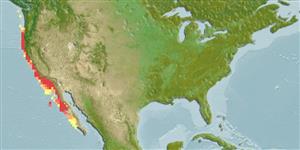(كوسه ها و سپرماهيان) (sharks and rays) >
Torpediniformes (Electric rays) >
Torpedinidae (Electric rays)
Etymology: californica: Named after the state of California (Ref. 6885).
More on author: Ayres.
Environment: milieu / climate zone / depth range / distribution range
بوم شناسي
دريايي نزديك كف زي; تغييرات عمق 0 - 906 m (Ref. 96339), usually 3 - 200 m (Ref. 55307). Temperate; 48°N - 23°N, 126°W - 110°W (Ref. 55307)
Eastern Pacific: Dixon Entrance, British Columbia, Canada to Sebastian Vizcaino Bay, Baja California, Mexico. Electric rays off Peru, Chile, and Japan may belong to this species (Ref. 2850).
Length at first maturity / Size / Weight / سن
Maturity: Lm ?, range 73 - ? cm
Max length : 140 cm TL جنس نر / بدون خواص جنسي; (Ref. 12951); 137.0 cm TL (female); common length : 91.0 cm TL جنس نر / بدون خواص جنسي; (Ref. 43939); common length :137 cm TL (female); بيشينه وزن گزارش شده: 0.00 g; بيشينه سن گزارش شده: 16 سال ها (Ref. 48844)
توصيف مختصر
كليدهاي شناسايي | ريخت شناسي | ريخت ستجي بوسيله انداره گيري
Gray with scattered black spots dorsally, no ocelli. 1st dorsal fin much larger than 2nd. Spiracle margin smooth and without papillae.
Found on the outer continental shelf, around rocks, in kelp beds, over fine sand bottoms or buried in sand. Solitary, nomadic, and can remain suspended in the water with minimal swimming (Ref. 12951). Feeds on bony fishes, mainly herrings and halibuts. Ovoviviparous (Ref. 50449). Produces litters of up to 17 pups. Males reaches maturity at ca. 65 cm TL, females at ca. 73 cm TL (Ref. 114953). Attacks their prey from the substratum by day and actively forage at night with the aid of its electric organ discharge or EOD (Ref. 10011). The EOD of a large individual was measured at 50 V; with a low internal organ resistance the power output exceeded 1 kW (Ref. 10480). Aggressive when provoked but no human has yet been injured by the electric shock (Ref. 2850). Does not do well in aquariums (Ref. 12951).
Life cycle and mating behavior
بلوغ | تولید مثل | تخم ریزی | تخم ها | Fecundity | توزاد ( لارو)
Exhibit ovoviparity (aplacental viviparity), with embryos feeding initially on yolk, then receiving additional nourishment from the mother by indirect absorption of uterine fluid enriched with mucus, fat or protein through specialised structures (Ref. 50449).
Reproductive cycle appears to be annual in males and biannual in females (Ref. 48844). No defined birthing season (Ref. 48844).
Allen, M.J. and G.B. Smith, 1988. Atlas and zoogeography of common fishes in the Bering Sea and northeastern Pacific. NOAA Tech. Rep. NMFS 66, 151 p. (Ref. 6793)
وضعيت در فهرست قرمز IUCN (Ref. 130435: Version 2024-1)
استفاده انسانی
ابزارها
گزارش های ويژه
بارگيری XML
منابع اينترنتي
Estimates based on models
Preferred temperature (Ref.
123201): 8.6 - 22.3, mean 12.8 °C (based on 100 cells).
Phylogenetic diversity index (Ref.
82804): PD
50 = 0.5001 [Uniqueness, from 0.5 = low to 2.0 = high].
Bayesian length-weight: a=0.01479 (0.00665 - 0.03288), b=2.96 (2.77 - 3.15), in cm total length, based on LWR estimates for this (Sub)family-body shape (Ref.
93245).
Trophic level (Ref.
69278): 4.5 ±0.80 se; based on food items.
جهندگی (Ref.
120179): پايين ، كم, كمينه زمان لازم براي دو برابر شدن جمعيت 5/4 – 14 سال (Fec = 17; tm=9; tmax=16).
Fishing Vulnerability (Ref.
59153): Very high vulnerability (79 of 100).
